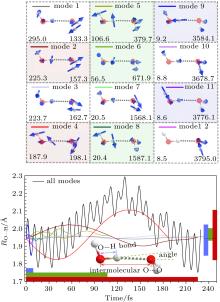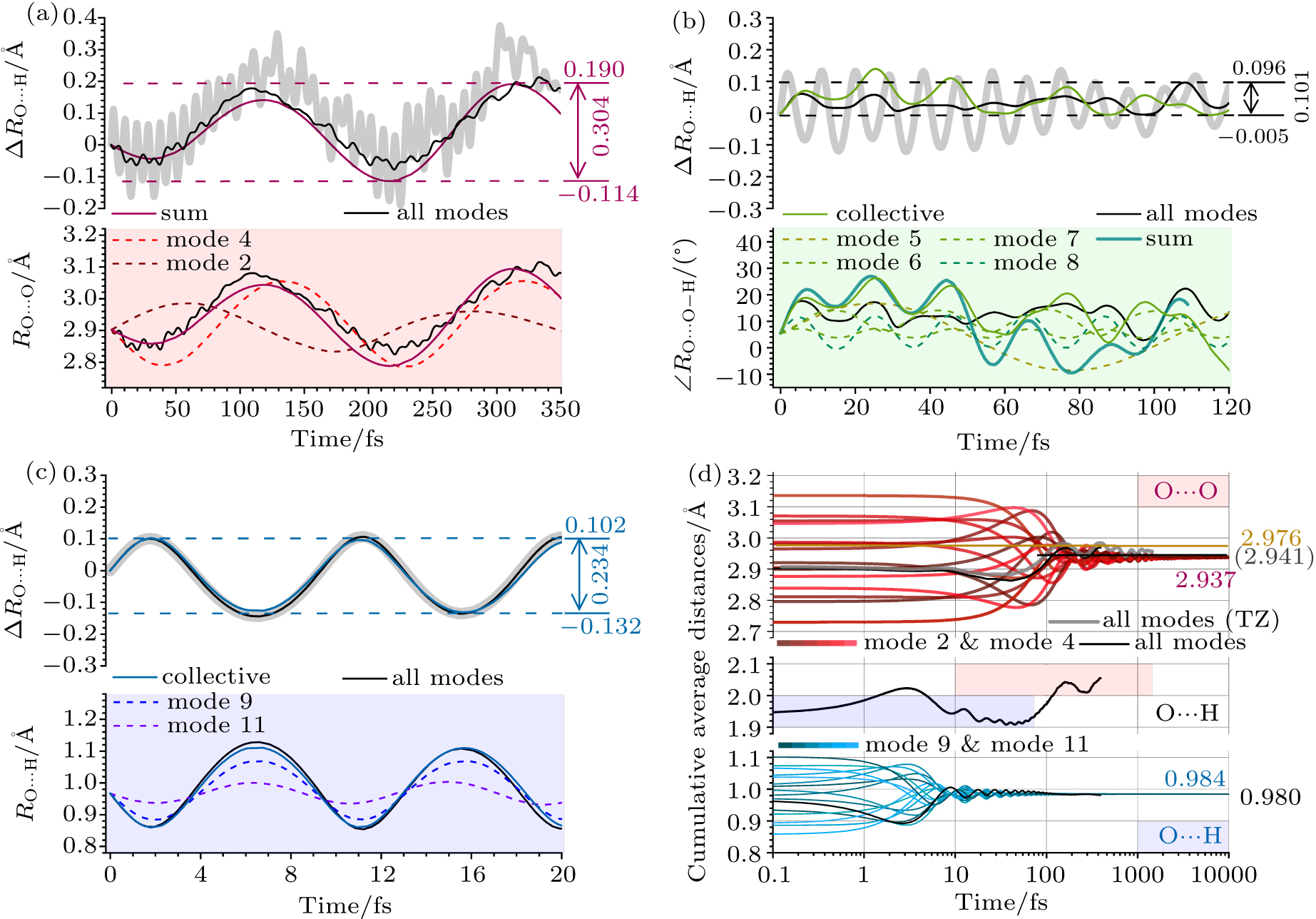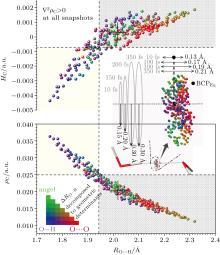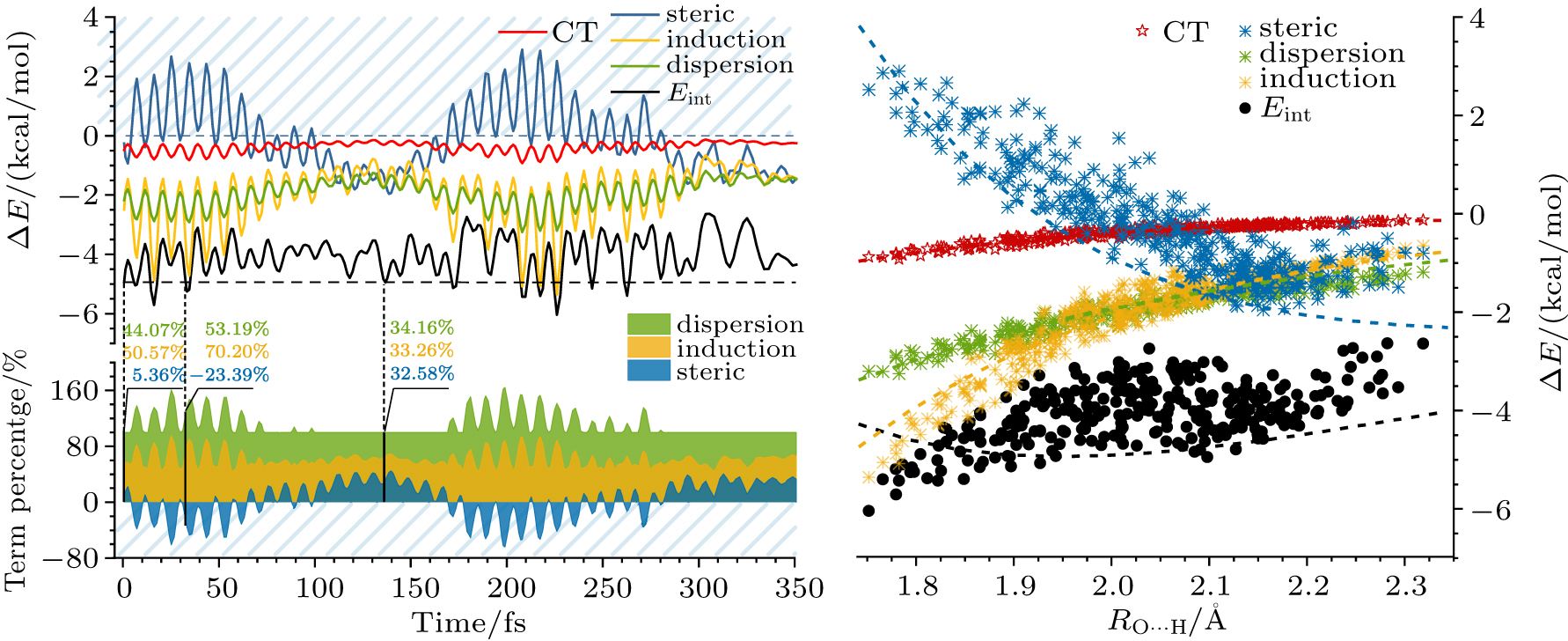中国物理B ›› 2020, Vol. 29 ›› Issue (10): 103101-.doi: 10.1088/1674-1056/abab6d
Wan-Run Jiang(姜万润)1, Rui Wang(王瑞)1, Xue-Guang Ren(任雪光)2, Zhi-Yuan Zhang(张志远)1, Dan-Hui Li(李丹慧)1, Zhi-Gang Wang(王志刚)1,†‡
-
收稿日期:2020-03-23修回日期:2020-07-22接受日期:2020-08-01出版日期:2020-10-05发布日期:2020-10-05 -
通讯作者:Zhi-Gang Wang(王志刚)
Zero-point fluctuation of hydrogen bond in water dimer from ab initio molecular dynamics
Wan-Run Jiang(姜万润)1,†, Rui Wang(王瑞)1,†, Xue-Guang Ren(任雪光)2, Zhi-Yuan Zhang(张志远)1, Dan-Hui Li(李丹慧)1, and Zhi-Gang Wang(王志刚)1,‡
- 1
Institute of Atomic and Molecular Physics, Jilin University , Changchun 130012,China
2School of Science, Xi’an Jiaotong University , Xi’an 710049,China
-
Received:2020-03-23Revised:2020-07-22Accepted:2020-08-01Online:2020-10-05Published:2020-10-05 -
Contact:†These authors contributed equally to this work. ‡Corresponding author. E-mail:wangzg@jlu.edu.cn -
About author:†Corresponding author. E-mail: wangzg@jlu.edu.cn* Project supported by the National Natural Science Foundation of China (Grant Nos. 11974136 and 11674123).
中图分类号: (Theory of electronic structure, electronic transitions, and chemical binding)
- 31.10.+z
引用本文
Wan-Run Jiang(姜万润), Rui Wang(王瑞), Xue-Guang Ren(任雪光), Zhi-Yuan Zhang(张志远), Dan-Hui Li(李丹慧), Zhi-Gang Wang(王志刚). [J]. 中国物理B, 2020, 29(10): 103101-.
Wan-Run Jiang(姜万润)†, Rui Wang(王瑞)†, Xue-Guang Ren(任雪光), Zhi-Yuan Zhang(张志远), Dan-Hui Li(李丹慧), and Zhi-Gang Wang(王志刚)‡. Zero-point fluctuation of hydrogen bond in water dimer from ab initio molecular dynamics[J]. Chin. Phys. B, 2020, 29(10): 103101-.
| [1] |
Meng X, Guo J, Peng J, Chen J, Wang Z, Shi J R, Li X Z, Wang E G, Jiang Y 2015 Nat. Phys. 11 235 DOI: 10.1038/nphys3225
|
| [2] |
Cleland W, Kreevoy M 1994 Science 264 1887 DOI: 10.1126/science.8009219
|
| [3] |
Sun T, Lin F H, Campbell R L, Allingham J S, Davies P L 2014 Science 343 795 DOI: 10.1126/science.1247407
|
| [4] |
Ch’ng L C, Samanta A K, Czakó G, Bowman J M, Reisler H 2012 J. Am. Chem. Soc. 134 15430 DOI: 10.1021/ja305500x
|
| [5] |
Zhang J, Chen P, Yuan B, Ji W, Cheng Z, Qiu X 2013 Science 342 611 DOI: 10.1126/science.1242603
|
| [6] |
Kumagai T, Kaizu M, Hatta S, Okuyama H, Aruga T, Hamada I, Morikawa Y 2008 Phys. Rev. Lett. 100 166101 DOI: 10.1103/PhysRevLett.100.166101
|
| [7] |
Guo J, Lü J T, Feng Y, Chen J, Peng J, Lin Z, Meng X, Wang Z, Li X Z, Wang E G, Jiang Y 2016 Science 352 321 DOI: 10.1126/science.aaf2042
|
| [8] |
Zhou C, Li X, Gong Z, Jia C, Lin Y, Gu C, He G, Zhong Y, Yang J, Guo X 2018 Nat. Commun. 9 807 DOI: 10.1038/s41467-018-03203-1
|
| [9] |
Li X Z, Walker B, Michaelides A 2011 Proc. Natl. Acad. Sci. USA 108 6369 DOI: 10.1073/pnas.1016653108
|
| [10] |
Ceriotti M, Cuny J, Parrinello M, Manolopoulos D E 2013 Proc. Natl. Acad. Sci. USA 110 15591 DOI: 10.1073/pnas.1308560110
|
| [11] |
Arunan E, Mani D 2015 Faraday Discuss. 177 51 DOI: 10.1039/C4FD00167B
|
| [12] |
Hiroto T 2017 J. Comput. Chem. 38 1503 DOI: 10.1002/jcc.v38.17
|
| [13] |
Cruzan J D, Braly L B, Liu K, Brown M G, Loeser J G, Saykally R J 1996 Science 271 59 DOI: 10.1126/science.271.5245.59
|
| [14] |
Asensio A, Kobko N, Dannenberg J J 2003 J. Phys. Chem. A 107 6441 DOI: 10.1021/jp0344646
|
| [15] |
Louit G, Hocquet A, Ghomi M, Meyer M, Sühnel J 2003 J. Phys. Chem. Commun. 6 1 DOI: 10.1039/b210911e
|
| [16] |
Shi Y L, Zhang Z Y, Jiang W R, Wang R, Wang Z G 2019 J. Mol. Liq. 286 110940 DOI: 10.1016/j.molliq.2019.110940
|
| [17] |
Fraser G T 1991 Int. Rev. Phys. Chem. 10 189 DOI: 10.1080/01442359109353257
|
| [18] |
Scheiner S 1994 Annu. Rev. Phys. Chem. 45 23 DOI: 10.1146/annurev.pc.45.100194.000323
|
| [19] |
Mukhopadhyay A, Cole W T S, Saykally R J 2015 Chem. Phys. Lett. 633 13 DOI: 10.1016/j.cplett.2015.04.016
|
| [20] |
Mukhopadhyay A, Xantheas S S, Saykally R J 2018 Chem. Phys. Lett. 700 163 DOI: 10.1016/j.cplett.2018.03.057
|
| [21] |
Odutola J A, Dyke T R 1980 J. Chem. Phys. 72 5062 DOI: 10.1063/1.439795
|
| [22] |
Klopper W, van Duijneveldt-van de Rijdt J G C M, van Duijneveldt F B 2000 Phys. Chem. Chem. Phys. 2 2227 DOI: 10.1039/a910312k
|
| [23] |
Lane J R 2013 J. Chem. Theory Comput. 9 316 DOI: 10.1021/ct300832f
|
| [24] |
Cowan M L, Bruner B D, Huse N, Dwyer J R, Chugh B, Nibbering E T J, Elsaesser T, Miller R J D 2005 Nature 434 199 DOI: 10.1038/nature03383
|
| [25] |
Ramasesha K, De Marco L, Mandal A, Tokmakoff A 2013 Nat. Chem. 5 935 DOI: 10.1038/nchem.1757
|
| [26] |
Bader R F W 1994 Atoms in Molecules: A Quantum Theory Oxford Clarendon Press
|
| [27] |
Cremer D, Kraka E 1984 Croat. Chem. Acta 57 1259 https://hrcak.srce.hr/file/286247
|
| [28] |
Koch U, Popelier P L A 1995 J. Chem. Phys. 99 9747 DOI: 10.1021/j100024a016
|
| [29] |
Isaacs E D, Shukla A, Platzman P M, Hamann D R, Barbiellini B, Tulk C A 1999 Phys. Rev. Lett. 82 600 DOI: 10.1103/PhysRevLett.82.600
|
| [30] |
Rozas I, Alkorta I, Elguero J 2000 J. Am. Chem. Soc. 122 11154 DOI: 10.1021/ja0017864
|
| [31] |
Grabowski S J 2011 Chem. Rev. 111 2597 DOI: 10.1021/cr800346f
|
| [32] |
Elgabarty H, Khaliullin R Z, Kühne T D 2015 Nat. Commun. 6 8318 DOI: 10.1038/ncomms9318
|
| [33] |
Zhang Z, Li D, Jiang W, Wang Z 2018 Adv. Phys. X 3 1428915 DOI: 10.1080/23746149.2018.1428915
|
| [34] |
Zhang Z Y, Jiang W R, Wang B, Yang Y Q, Wang Z G 2018 Chin. Phys. B 27 013102 DOI: 10.1088/1674-1056/27/1/013102
|
| [35] |
Jeziorski B, van Hemert M 1976 Mol. Phys. 31 713 DOI: 10.1080/00268977600100551
|
| [36] |
Umeyama H, Morokuma K 1977 J. Am. Chem. Soc. 99 1316 DOI: 10.1021/ja00447a007
|
| [37] |
Morokuma K 1977 Acc. Chem. Res. 10 294 DOI: 10.1021/ar50116a004
|
| [38] |
Rybak S, Jeziorski B, Szalewicz K 1991 J. Chem. Phys. 95 6576 DOI: 10.1063/1.461528
|
| [39] |
Mo Y, Gao J, Peyerimhoff S D 2000 J. Chem. Phys. 112 5530 DOI: 10.1063/1.481185
|
| [40] |
Khaliullin R Z, Bell A T, Head-Gordon M 2009 Chem. - Eur. J. 15 851 DOI: 10.1002/chem.200802107
|
| [41] |
Hoja J, Sax A F, Szalewicz K 2014 Chem. - Eur. J. 20 2292 DOI: 10.1002/chem.201303528
|
| [42] |
Wang B, Jiang W, Dai X, Gao Y, Wang Z, Zhang R Q 2016 Sci. Rep. 6 22099 DOI: 10.1038/srep22099
|
| [43] |
Tafipolsky M 2016 J. Phys. Chem. A 120 4550 DOI: 10.1021/acs.jpca.6b04861
|
| [44] |
Mitsui T, Rose M K, Fomin E, Ogletree D F, Salmeron M 2002 Science 297 1850 DOI: 10.1126/science.1075095
|
| [45] |
Ranea V A, Michaelides A, Ramírez R, de Andres P L, Vergés J A, King D A 2004 Phys. Rev. Lett. 92 136104 DOI: 10.1103/PhysRevLett.92.136104
|
| [46] |
Xu X, Goddard W A 2004 J. Phys. Chem. A 108 2305 DOI: 10.1021/jp035869t
|
| [47] |
Sun J, Remsing R C, Zhang Y, Sun Z, Ruzsinszky A, Peng H, Yang Z, Paul A, Waghmare U, Wu X, Klein M L, Perdew J P 2016 Nat. Chem. 8 831 DOI: 10.1038/nchem.2535
|
| [48] |
Møller C, Plesset M S 1934 Phys. Rev. 46 618 DOI: 10.1103/PhysRev.46.618
|
| [49] |
Head-Gordon M, Pople J A, Frisch M J 1988 Chem. Phys. Lett. 153 503 DOI: 10.1016/0009-2614(88)85250-3
|
| [50] |
Sinha P, Boesch S E, Gu C, Wheeler R A, Wilson A K 2004 J. Phys. Chem. A 108 9213 DOI: 10.1021/jp048233q
|
| [51] |
Helgaker T, Uggerud E, Jensen H J A 1990 Chem. Phys. Lett. 173 145 DOI: 10.1016/0009-2614(90)80068-O
|
| [52] |
Millam J M, Bakken V, Chen W, Hase W L, Schlegel H B 1999 J. Chem. Phys. 111 3800 DOI: 10.1063/1.480037
|
| [53] |
Jeziorski B, Moszynski R, Szalewicz K 1994 Chem. Rev. 94 1887 DOI: 10.1021/cr00031a008
|
| [54] |
Stone A J, Misquitta A J 2009 Chem. Phys. Lett. 473 201 DOI: 10.1016/j.cplett.2009.03.073
|
| [55] |
Parker T M, Burns L A, Parrish R M, Ryno A G, Sherrill C D 2014 J. Chem. Phys. 140 094106 DOI: 10.1063/1.4867135
|
| [56] |
Frisch M J, Trucks G W, Schlegel H B et al. 2009 Gaussian 09, Revision D.01 Gaussian, Inc. Wallingford, CT http://gaussian.com/gaussian16
|
| [57] |
Parrish R M, Burns L A, Smith D G A, Simmonett A C, DePrince A E, Hohenstein E G, Bozkaya U, Sokolov A Y, Di Remigio R, Richard R M, Gonthier J F, James A M, McAl-exander H R, Kumar A, Saitow M, Wang X, Pritchard B P, Verma P, Schaefer H F, Patkowski K, King R A, Valeev E F, Evangelista F A, Turney J M, Crawford T D, Sherrill C D 2017 J. Chem. Theory Comput. 13 3185 DOI: 10.1021/acs.jctc.7b00174
|
| [58] |
Lu T, Chen F 2012 J. Comput. Chem. 33 580 DOI: 10.1002/jcc.v33.5
|
| [59] |
Ceponkus J, Engdahl A, Uvdal P, Nelander B 2013 Chem. Phys. Lett. 581 1 DOI: 10.1016/j.cplett.2013.06.046
|
| [60] |
Cole W T S, Fellers R S, Viant M R, Leforestier C, Saykally R J 2015 J. Chem. Phys. 143 154306 DOI: 10.1063/1.4933116
|
| [61] |
Czakó G, Kaledin A L, Bowman J M 2010 J. Chem. Phys. 132 164103 DOI: 10.1063/1.3417999
|
| [62] |
Mori-Sánchez P, Pendás A M, Luaña V 2001 Phys. Rev. B 63 125103 DOI: 10.1103/PhysRevB.63.125103
|
| [63] |
Costales A, Blanco M A, Martín Pendás A, Mori-Sánchez P, Luaña V 2004 J. Phys. Chem. A 108 2794 DOI: 10.1021/jp037627z
|
| [64] |
Foroutan-Nejad C, Shahbazian S, Marek R 2014 Chem. - Eur. J. 20 10140 DOI: 10.1002/chem.201402177
|
| [65] |
Jenkins S, Morrison I 2000 Chem. Phys. Lett. 317 97 DOI: 10.1016/S0009-2614(99)01306-8
|
| [66] |
Grabowski S J, Sokalski W A, Dyguda E, Leszczyńki J 2006 J. Phys. Chem. B 110 6444 DOI: 10.1021/jp0600817
|
| [67] |
Grabowski S J 2006 Hydrogen bonding-new insights Dordrecht Springer DOI: 10.1007/978-1-4020-4853-1
|
| [68] |
Medvedev M G, Bushmarinov I S, Sun J, Perdew J P, Lyssenko K A 2017 Science 355 49 DOI: 10.1126/science.aah5975
|
| [69] |
McDaniel J G, Schmidt J R 2013 J. Phys. Chem. A 117 2053 DOI: 10.1021/jp3108182
|
| [70] |
Boys S F, Bernardi F 1970 Mol. Phys. 19 553 DOI: 10.1080/00268977000101561
|
| [71] |
Gregory J K, Clary D C, Liu K, Brown M G, Saykally R J 1997 Science 275 814 DOI: 10.1126/science.275.5301.814
|
| [72] |
Skarmoutsos I, Masia M, Guardia E 2016 Chem. Phys. Lett. 648 102 DOI: 10.1016/j.cplett.2016.02.008
|
| [73] |
Otto K E, Xue Z, Zielke P, Suhm M A T 2014 Phys. Chem. Chem. Phys. 16 9849 DOI: 10.1039/c3cp54272f
|
|
||







